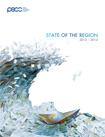State of the Region 2012-2013
 Growth in the Asia-Pacific this year is expected to increase slightly to 3.7 percent from last year’s 3.5 percent. Looking ahead to 2013, growth will be much the same at 3.9 percent. However, these forecasts, based on the IMF’s World Economic Outlook are based on some assumptions: that financial conditions on the Eurozone will ease; expansionary policies in emerging markets will gain traction; and the United States will find a solution to the fiscal dilemma it faces at the end of the year. In short, the downside risks to the forecast are enormous and uncertainty remains abundant.
Growth in the Asia-Pacific this year is expected to increase slightly to 3.7 percent from last year’s 3.5 percent. Looking ahead to 2013, growth will be much the same at 3.9 percent. However, these forecasts, based on the IMF’s World Economic Outlook are based on some assumptions: that financial conditions on the Eurozone will ease; expansionary policies in emerging markets will gain traction; and the United States will find a solution to the fiscal dilemma it faces at the end of the year. In short, the downside risks to the forecast are enormous and uncertainty remains abundant.
Download:
![]() default
default
State of the Region Report 2012
(1.86 MB)
default
default
State of the Region Report 2012
(1.86 MB)
Content:
i Message from the Co-Chairs of PECC
ii Message from the Coordinator
iii Executive Summary
Chapter 1: Eurozone & US Economic Woes: Impact on the Asia-Pacific
by Roberto Mariano
- Eurozone & US Economic Woes: Impact on the Asia-Pacific
- Figure 1: GDP Growth
- Box 1-1 – Disasters and Supply Chains in the Region by Minquan Liu & Shanawez Hossain
- Figure A: Economic Costs of Natural Disasters to the Asia-Pacific
- Table A: Rate of dependence on Japan for parts and materials
- Figure B: Impact of Japanese Earthquake on Regional Production Networks
- Table 1: Weighted Average GDP Growth
- Less Concern over Headline Inflation
- Figure 2: Inflation
- Figure 3: Commodity Prices (indexed at January 2005)
- Current Account Imbalances
- Figure 4: Current Account Balances
- The Eurozone Debt Crisis and the Asia-Pacific
- Exposure through Trade Channel
- Figure 5: Export Growth
- Figure 6: Import Growth
- Exports to the European Union
- Figure 7: Asia-Pacific Economies’ Exports to the European Union (annual average 2002-2011)
- Figure 8: Change in Selected Asia-Pacific Economies' Exports to the EU
- Figure 9: European Holdings of Assets in Asia-Pacific Economies
- Policy Tools and Programs for Managing Capital Flows in Asia
Chapter 2: Opinion Leaders’ Survey
by Eduardo Pedrosa
- Opinion Leaders’ Survey
- Figure 1: Expectations for Growth of the World Economy over the Next 12 Months
- Figure 2: Expectations for World Economic Growth by Sub-Region
- Figure 3: Expectations for Growth of Select Economies/Sub-Regions
- Growing Pessimism on Emerging Markets
- Opportunities for Growth
- Figure 4: Top 10 Regional Best Opportunities for Growth
- Myanmar
- Figure 5: Myanmar as an Opportunity for Growth
- Risks to Growth
- Figure 6: Risks to Growth
- Figure 7: Views on Growing Income Inequality as a Risk to Growth
- Figure 8: Views on Protectionism as a Risk to Growth
- Box 2-1: Myanmar: Are the reforms for real? by Thaung Tun
- The Eurozone Crisis
- Figure 9: Impact of the Eurozone Crisis
- Figure 10: Policy Challenges from the Eurozone
- Priorities for Trade Agreements
- Figure 11: Priority Issues for Regional Trade Agreements
- Labor and the Environment: Divergence among Emerging Economies
- Figure 12: Labor and Environment as Priority Issues for Regional Trade Agreements
- Pathways to a Free Trade Area of the Asia-Pacific
- Figure 13: Likelihood of Success of Various Regional Trade Agreements
- East Asian Free Trade Area (ASEAN Plus 3)
- Figure 14: Likelihood of Success of EAFTA by Group Membership
- Figure 15: Likelihood of Success of Various Regional Trade Agreements
- Which Pathway for FTAAP?
- Figure 16: Most Promising Pathways to FTAAP
- Figure 17: Significant Lack of Awareness on RCEP and CEPEA
- Top Issues for APEC Leaders’ Meeting
- Russia’s Priorities Well Supported by Regional Opinion Leaders
- Region Divided on the Doha Round
- Figure 18: Decline of Support for WTO as a Top APEC Leaders' Issue (2007 –2012)
- Figure 19: Diverse Views on WTO DDA as an APEC Leaders’ Issue (2012)
Chapter 3: Asian and Trans-Pacific Initiatives in Regional Integration
by Peter A. Petri and Tri Thanh Vo
- Asian and Trans-Pacific Initiatives in Regional Integration
- Table 1. Trade flows in the Asia-Pacific region, 2010 ($bn)
- The Asian Track
- The Trans-Pacific Track
- Contrasting Templates
- Figure 1. Average scores of provisions on major issues
- Box 3-1: The TPP: A minefield of issues
- Box 3-2: Is ASEAN Centrality at Risk?
- Economic Effects
- Table 2. Income gains in 2025
- Policy Implications
- References
Chapter 4: Index Of Regional Economic Integration
by Chen Bo
- Index Of Regional Economic Integration
- Figure 1: Composite Index of Regional Economic Integration
- Economic Slowdown Takes Toll on Regional Integration
- Figure 2: Composite Index of Regional Economic Integration
- Table 1: Comparison of 2008 and 2009 indices
- Intra-Regional Flows Impacted by Crisis
- Figure 3: Intra-Regional Trade Flows
- Figure 4: Intra-Regional Investment Flows
- Figure 5: Intra-Regional Tourist Flows
- The Convergence Index
- Income Inequality in the Region
- Figure 6: GDP per capita in 1990
- Figure 7: GDP per capita in 2009
- Figure 8: Convergence Index
- Methodology